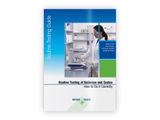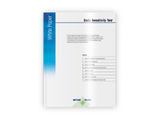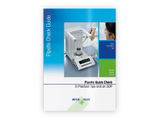To use all functions of this page, please activate cookies in your browser.
my.bionity.com
With an accout for my.bionity.com you can always see everything at a glance – and you can configure your own website and individual newsletter.
- My watch list
- My saved searches
- My saved topics
- My newsletter
Hemolytic anemia
Hemolytic anemia is anemia due to hemolysis, the abnormal breakdown of red blood cells either in the blood vessels (intravascular hemolysis) or elsewhere in the body (extravascular). It has numerous possible causes, ranging from relatively harmless to life-threatening. The general classification of hemolytic anemia is either acquired or inherited. Treatment depends on the cause and nature of the breakdown. In a healthy person, a red blood cell survives 90 to 120 days (on average) in the circulation, so about 1% of human red blood cells break down each day. The spleen (part of the reticulo-endothelial system) is the main organ which removes old and damaged RBCs from the circulation. In health the break down and removal of RBCs from the circulation is matched by the production of new RBCs in the bone marrow. In conditions where the rate of RBC breakdown is increased, the body initially compensates by producing more RBCs; however, breakdown of RBCs can exceed the rate that the body can make RBCs, and so anemia can develop. Bilirubin, a breakdown product of hemoglobin, can accumulate in the blood causing jaundice, and be excreted in the urine causing the urine to become a dark brown colour. Additional recommended knowledge
SymptomsSigns of anemia are generally present (fatigue, later heart failure). Jaundice may be present.
Tests
Clinical findings in haemolytic anaemias: 1. increased serum bilirubin levels in blood, therefore jaundice 2. pallor in mucous membrane and skin 3. increased urobilinogen in urine..urine turns dark on standing 4. Splenomegaly 5. Pigmented gallstones may be found Classification of hemolytic anaemiasCauses of haemolytic anaemis can be either genetic or acquired. Genetic
AcquiredAcquired haemolytic anaemia can be further divided into immune and non-immune mediated. Immune mediated hemolytic anaemia (direct Coombs test is positive)
Non-immune mediated haemolytic anaemia (direct Coombs test is negative)
Drug induced hemolysisDrug induced hemolysis has large clinical relevance. It occurs when drugs actively provoke red cell destruction. Four mechanisms are described below. ImmunePenicillin in high doses can induce immune mediated hemolysis via the hapten mechanism in which antibodies are targeted against the combination of penicillin in association with red blood cells. Complement is activated by the attached antibody leading to the removal of red blood cells by the spleen. The drug itself can be targeted by the immune system, e.g. by IgE in a Type I hypersensitivity reaction to penicillin, rarely leading to anaphylaxis. Non-immuneNon-immune drug induced hemolysis can occur via oxidative mechanisms. This is particularly likely to occur when there is an enzyme deficiency in the antioxidant defence system of the red blood cells. An example is where antimalarial oxidant drugs like primaquine damage red blood cells in Glucose-6-phosphate dehydrogenase deficiency in which the red blood cells are more susceptible to oxidative stress due to reduced NADPH production consequent to the enzyme deficiency. Some drugs cause RBC (red blood cell) lysis even in normal individuals. These include dapsone and sulfasalazine. Non-immune drug-induced hemolysis can also arise from drug-induced damage to cell volume control mechanisms; for example drugs can directly or indirectly impair regulatory volume decrease mechanisms, which become activated during hypotonic RBC swelling to return the cell to a normal volume. The consequence of the drugs actions are irreversible cell swelling and lysis (e.g. ouabain at very high doses). Differential diagnosis
TherapyDefinitive therapy depends on the cause.
Categories: Blood disorders | Hematology |
|||||||||||||
| This article is licensed under the GNU Free Documentation License. It uses material from the Wikipedia article "Hemolytic_anemia". A list of authors is available in Wikipedia. |







